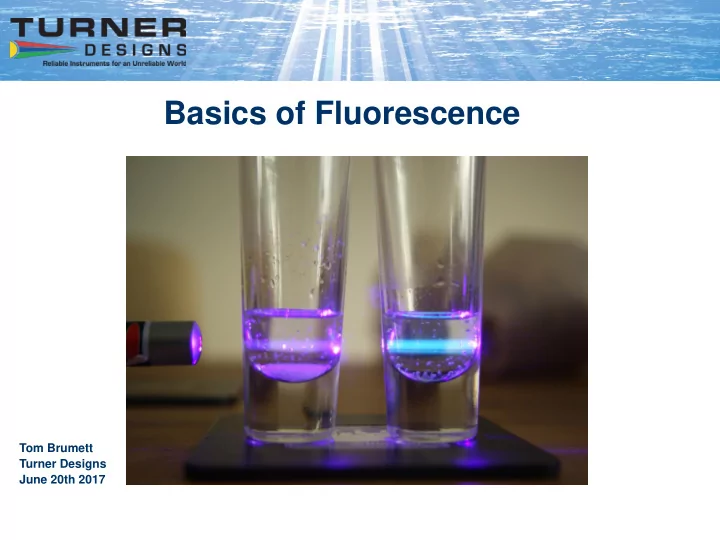

Basics of Fluorescence Tom Brumett Turner Designs June 20th 2017
Fluorescence The molecular absorption of light energy at one wavelength and its nearly instantaneous re-emission at another wavelength. • Emitted light is always a longer wavelength than the absorbed light due to energy loss by the molecule prior to emission.
Excitation and Emission Fluorescent compounds have two characteristic spectra • Excitation spectrum (the wavelength and amount of light absorbed) • Emission spectrum (the wavelength and amount of light emitted).
Filter Fluorometer Digital Readout Light Detector Wavelengths specific to compound Emission Filter Wavelengths created by compound, plus stray light Light Cuvette or source Sample Cell Excitation Filter Specific wavelengths of light Many wavelengths of light
Light Source Provides the energy that excites the compound of interest by emitting light of the desired wavelength • Most common are Light Emitting Diodes (LED)
Optical Filters Colored glass filters have high energy transmittance which enhances sensitivity of fluorometers. However, they are broad bandwidth, typically allowing bandwidths of more than 100 nm to pass and provide marginal wavelength discrimination. Interference filters can provide narrow bandwidths, typically 5 to 25 nm wide, which makes them superior for wavelength selection in a fluorometer.
Light Detectors Photomultipliers or photodiodes • Emitted light intensity produces a proportional electrical current in the detector. This current is converted to a voltage providing a digital readout.
Some Fluorescence Applications Environmental monitoring • Assess health of the ocean • Identify harmful algal blooms (HABs) Oil spill tracking Aquaculture • Monitor fish food • Determine fish freshness Drinking water monitoring • Assess health of the intake water Wastewater monitoring • Identify disposal sites Dye tracing • Track water flow DNA detection
Some Fluorescence Wavelengths Excitation Emission Chlorophyll 465nm 700nm Phycocyanin 609nm 643nm Crude Oil 365nm 550nm Refined Fuels 285nm 340nm Optical Brighteners 365nm 445nm DOM 365nm 500nm Rhodamine Dye 530nm 610nm Fluorescein Dye 442nm 530nm Hoechst Dye 365nm 510nm
Recommend
More recommend